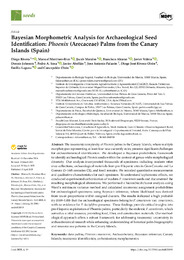Please use this identifier to cite or link to this item:
https://hdl.handle.net/11000/38292Full metadata record
| DC Field | Value | Language |
|---|---|---|
| dc.contributor.author | Rivera, Diego | - |
| dc.contributor.author | Martínez - Rico, Manuel | - |
| dc.contributor.author | Morales, Jacob | - |
| dc.contributor.author | Alcaraz, Francisco | - |
| dc.contributor.author | Valera, Javier | - |
| dc.contributor.author | Jhonson, Dennis | - |
| dc.contributor.author | Sosa, Pedro A. | - |
| dc.contributor.author | Abellán, Javier | - |
| dc.contributor.author | Palazón, José Antonio | - |
| dc.contributor.author | Rivera-Obón, Diego José | - |
| dc.contributor.author | Laguna, Emilio | - |
| dc.contributor.author | Obón, Concepción | - |
| dc.contributor.other | Departamentos de la UMH::Biología Aplicada | es_ES |
| dc.date.accessioned | 2025-11-18T12:32:13Z | - |
| dc.date.available | 2025-11-18T12:32:13Z | - |
| dc.date.created | 2025 | - |
| dc.identifier.citation | Seeds 2025, 4(2) | es_ES |
| dc.identifier.issn | 2674-1024 | - |
| dc.identifier.uri | https://hdl.handle.net/11000/38292 | - |
| dc.description.abstract | The taxonomic complexity of Phoenix palms in the Canary Islands, where multiple morphotypes representing at least four taxa currently exist, presents significant challenges for archaeobotanical identification. We developed a Bayesian probabilistic framework to identify archaeological Phoenix seeds within the context of genus-wide morphological diversity. Our analysis incorporated thousands of specimens including modern reference collections, archaeological materials from pre-Hispanic sites in Gran Canaria and La Gomera (3–16th centuries CE), and fossil remains. We recorded quantitative measurements and qualitative characteristics for each specimen. To understand taphonomic effects, we conducted experimental carbonization of modern P. canariensis seeds and documented the resulting morphological alterations. We performed a hierarchical cluster analysis using Ward’s minimum variance method and calculated taxonomic assignment probabilities for archaeological specimens using Bayesian inference, where likelihood was derived from taxon proportions within assigned clusters. The results indicated a high probability (0.69–1.00) that the archaeological specimens belong to P. canariensis var. canariensis, with no evidence for P. dactylifera presence. These findings provide critical insights into pre-Hispanic exploitation of Phoenix palms, particularly the endemic P. canariensis, which served as a vital resource, providing food, fiber, and construction materials. Our methodological approach offers a robust framework for addressing taxonomic uncertainty in archaeobotanical research while enhancing understanding of historical palm biogeography and resource use patterns in the Canary Islands. | es_ES |
| dc.format | application/pdf | es_ES |
| dc.format.extent | 33 | es_ES |
| dc.language.iso | eng | es_ES |
| dc.publisher | MDPI | es_ES |
| dc.rights | info:eu-repo/semantics/openAccess | es_ES |
| dc.rights.uri | http://creativecommons.org/licenses/by-nc-nd/4.0/ | * |
| dc.subject | date palms | es_ES |
| dc.subject | Phoenix canariensis | es_ES |
| dc.subject | Archaeobotany | es_ES |
| dc.subject | Bayesian inference | es_ES |
| dc.subject | Canary Islands | es_ES |
| dc.subject.other | CDU::5 - Ciencias puras y naturales::57 - Biología | es_ES |
| dc.title | Bayesian Morphometric Analysis for Archaeological Seed Identification: Phoenix (Arecaceae) Palms from the Canary Islands (Spain) | es_ES |
| dc.type | info:eu-repo/semantics/article | es_ES |
| dc.relation.publisherversion | https://doi.org/10.3390/seeds4020019 | es_ES |

View/Open:
seeds-04-00019.pdf
7,77 MB
Adobe PDF
Share:
.png)
